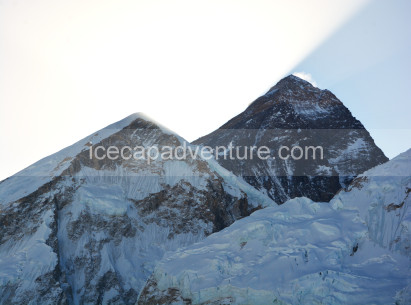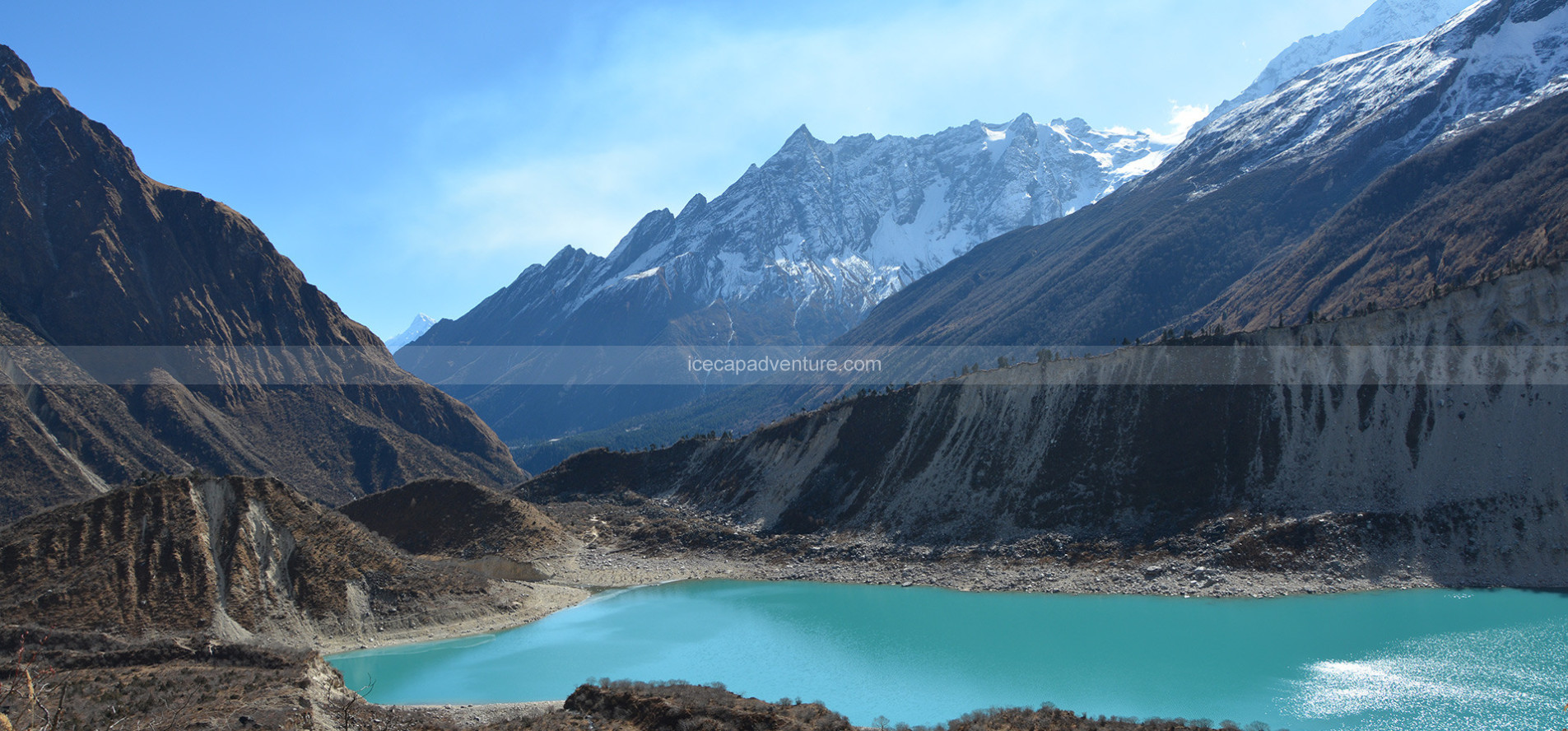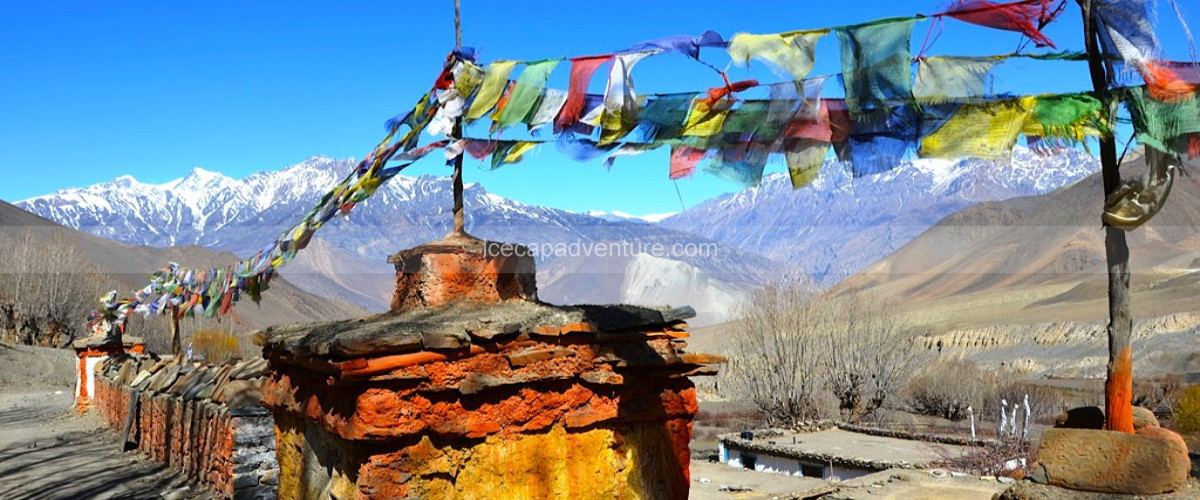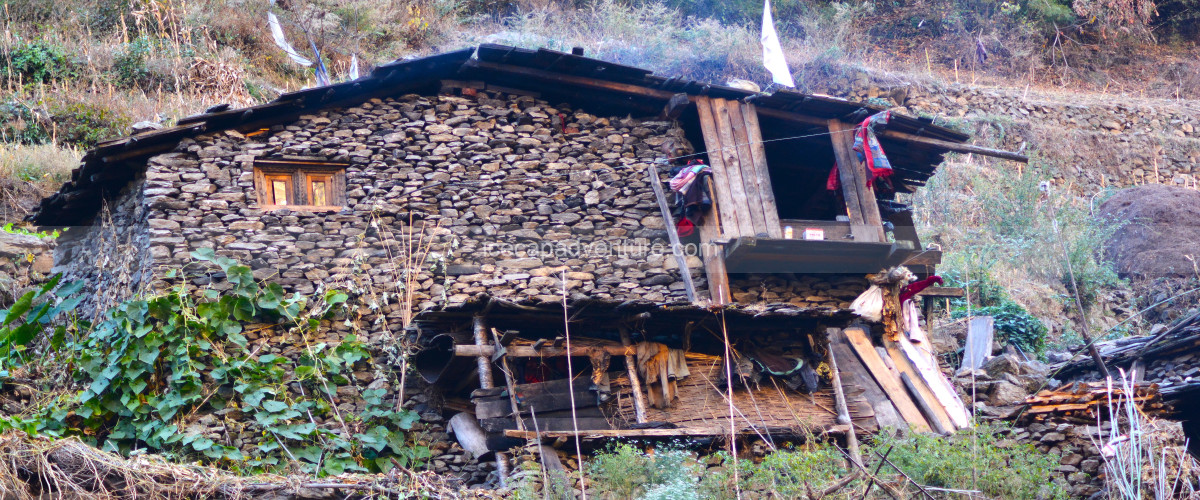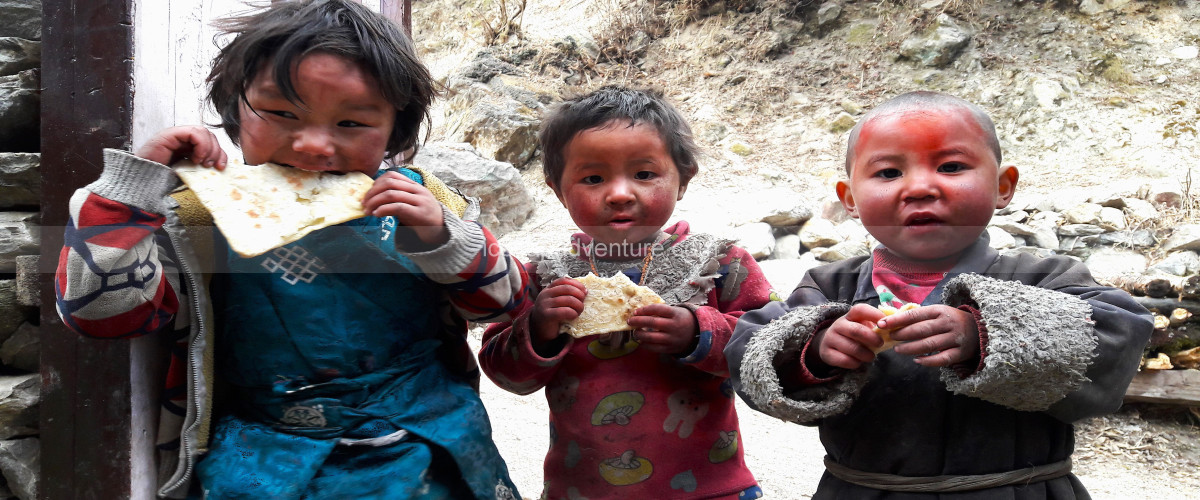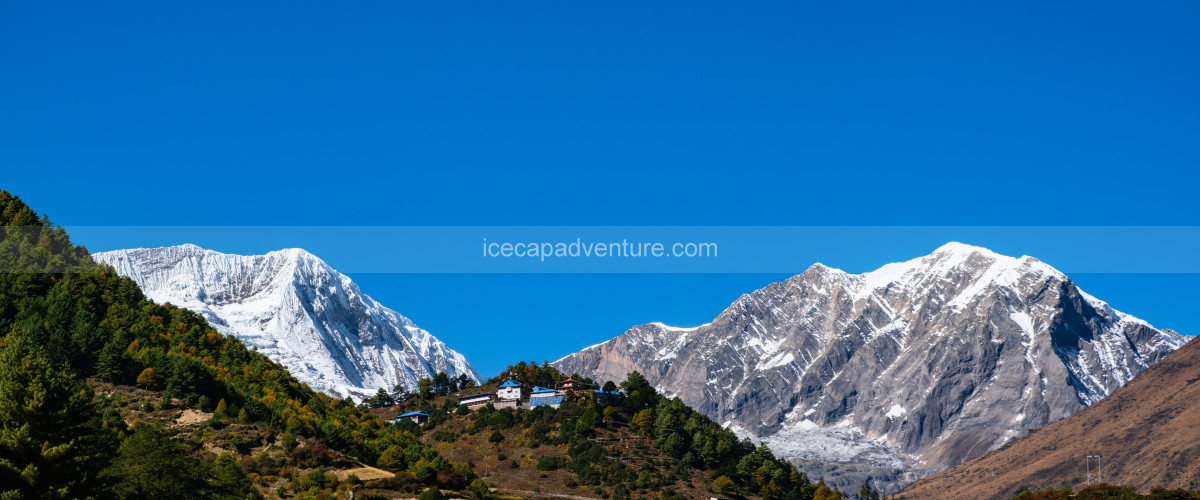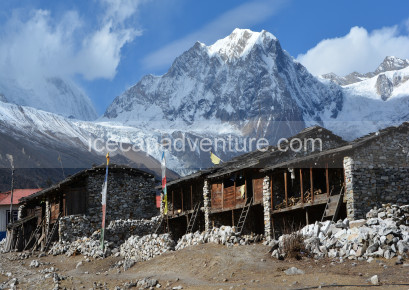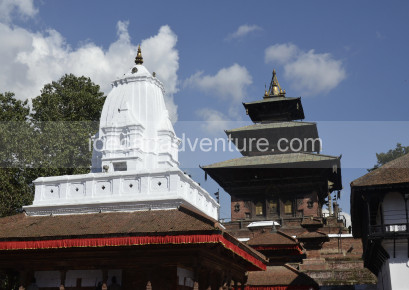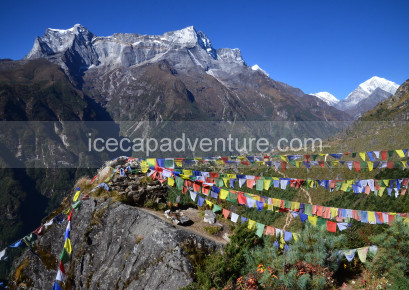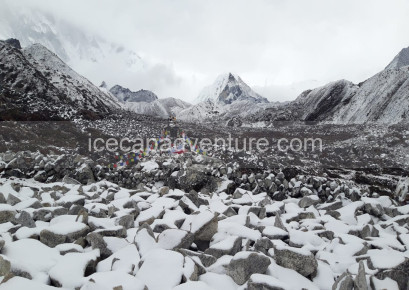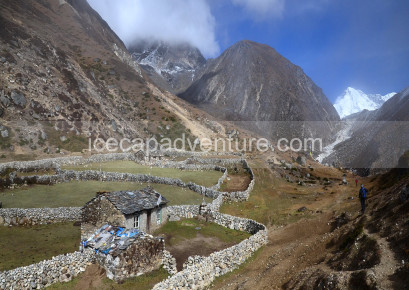.png)
.png)
.png)
.png)
.png)
.png)
.png)
.png)
Tsum Valley & Manaslu Trekking Overview
The Tsum Valley & Manaslu Trekking route is a hidden gem of Nepal, offering a blend of rugged Himalayan wilderness, ancient Buddhist heritage, and untouched cultural beauty. Located in the restricted Manaslu region, this trek takes you through remote valleys, dramatic gorges, lush forests, and high-altitude landscapes, culminating near the base of the world’s eighth-highest peak, Mount Manaslu (8,163m). This journey is perfect for adventurers who want an off-the-beaten-path experience with fewer crowds and deep cultural immersion.
Nature and Wildlife
The region falls under the Manaslu Conservation Area, making it rich in biodiversity. Trekkers can spot Himalayan thar, blue sheep, marmots, and diverse birdlife. Towering peaks such as Manaslu, Ganesh Himal, and Himalchuli dominate the backdrop, while the trails meander through alpine meadows, pine forests, and glacial rivers.
Trekking Challenges & Rewards
The trek is considered moderate to challenging due to long walking days, steep ascents, and the crossing of the dramatic Larkya La Pass (5,160m). Though demanding, the rewards are extraordinary—serene Himalayan views, untouched Buddhist monasteries, and the chance to explore hidden valleys like the sacred Tsum, often called the “Valley of Happiness.”
Best Seasons to Visit
The best time to trek in this region is during spring (March–May) and autumn (September–November). These months ensure stable weather, clear skies, and ideal conditions for crossing high passes and exploring monasteries.
Cultural Significance
The Tsum Valley is deeply rooted in Tibetan Buddhist traditions, home to centuries-old monasteries like Mu Gompa and Rachen Gompa. Prayer flags, mani walls, and chortens line the trail, reflecting the region’s spiritual richness. The Manaslu Circuit also introduces trekkers to Gurung villages, showcasing unique mountain hospitality.
Highlights of the Trek:
-
Crossing the high Larkya La Pass (5,160m) with stunning panoramas.
-
Exploring the mystical Tsum Valley with ancient monasteries.
-
Close-up views of Mount Manaslu (8,163m).
-
Diverse landscapes: deep gorges, alpine meadows, and glaciers.
-
Authentic cultural encounters with Tibetan-influenced communities.
1
We will be waiting to welcome you at Tribhuvan International Airport, Kathmandu, where you will be greeted with a traditional Nepali flower garland to mark your arrival. After the warm welcome, we will drive you to your hotel—approximately 30 minutes during the day and 20 minutes at night.
Upon reaching the hotel, you will be offered welcome drinks and biscuits, followed by the settlement of your rooms. Once settled, please join us back in the lobby or meeting hall for a briefing about your trekking and tour program on the Tshum Valley & Manaslu Trek, including an introduction to your trekking guide and other relevant details. After the briefing, you will have the opportunity to check your trekking equipment with your guide.
Note: If you arrive in Kathmandu at night, these activities will be scheduled for the following day after breakfast and meals.
.png)
.png)
.png)
.png)
2
After breakfast at the hotel, you will have time to explore Kathmandu’s cultural heritage sites, such as Kathmandu Durbar Square, Swayambhunath (Monkey Temple), or Boudhanath Stupa, and you will have the day to prepare for your trek.
Our team will assist you in checking your gear and ensuring you have all the necessary equipment for the journey ahead. If you need to buy or rent any trekking gear, we will guide you to the best shops in Thamel, where you can find quality items at reasonable prices.
In the evening, your trekking guide will conduct a final briefing about the trek, including route details, safety measures, and expected weather conditions. Overnight stay at a hotel in Kathmandu.
.png)
.png)
.png)
.png)
3
Today marks the beginning of your Helambu/Langtang trek journey by road. You will leave Kathmandu (1,350 m) early in the morning and embark on a scenic 7–8 hour drive to Machha Khola (1,300 m). The route passes through Kathmandu Valley, then winds along the Trishuli River, offering glimpses of terraced fields, small villages, and local life in rural Nepal. You may stop en route for tea, lunch, and short breaks to stretch and enjoy the surroundings. As you approach Machha Khola, the landscape gradually becomes more forested with river valleys and suspension bridges, setting the stage for the start of your trek. Upon arrival, check into your teahouse or guesthouse, relax, and enjoy your first evening in the Helambu region, preparing for the trek ahead.
Highlights of the Day:
-
Scenic drive along the Trishuli River with mountain views.
-
Stop at local villages to observe rural Nepali life.
-
Cross rivers via small suspension bridges along the way.
-
Arrival at Machha Khola (1,300 m), the starting point of your trek.
-
First night in a teahouse or guesthouse, relaxing and preparing for trekking.
.png)
.png)
.png)
.png)
4
The trek officially begins today, departing from Machha Khola (1,300 m) along the Bhote Koshi River. The trail gradually ascends through lush forests of bamboo, rhododendron, and pine, passing small Tamang villages and terraced farmlands. You will cross suspension bridges over the river multiple times, offering scenic views and opportunities for photos. Local villagers may greet you with warm smiles, and you’ll witness traditional Nepali rural life firsthand. The trail is moderately undulating, with several short uphill sections, but overall it is manageable for beginners and seasoned trekkers alike.
Arrival at Jagat (1,300 m) marks the first overnight stop. The village has cozy teahouses where you can enjoy a hot meal and rest after your first trekking day. This night also serves as an opportunity to prepare for the more challenging ascents in the coming days of the Helambu trek.
Highlights of the Day:
-
Trek through lush forests and terraced farmlands.
-
Cross multiple suspension bridges over the Bhote Koshi River.
-
Visit Tamang villages and experience local culture.
-
Moderate trekking with short uphill sections to get accustomed to the trail.
-
Overnight stay at Jagat (1,300 m) in a teahouse with dinner and rest.
.png)
.png)
.png)
.png)
5
Today’s trek takes you from Jagat (1,300 m) to Lokpa (1,630 m), gradually ascending through lush forests of rhododendron, pine, and bamboo. The trail follows the Bhote Koshi River initially, then begins to climb more steadily through traditional Tamang and Sherpa villages, offering insights into local culture and rural lifestyles. Along the way, you will cross several suspension bridges, walk past terraced fields, and enjoy scenic views of the surrounding hills and distant Himalayan peaks. The trek is moderately challenging due to the gradual uphill sections, allowing your body to adapt to higher altitudes.
Arrival at Lokpa (1,630 m) provides a cozy overnight stop at a teahouse, where you can enjoy a warm meal and interact with locals. This day sets the pace for the more demanding ascents in the coming days of the Helambu trek.
Highlights of the Day:
-
Gradual ascent through rhododendron, pine, and bamboo forests.
-
Cross several suspension bridges along the trail.
-
Pass through Tamang and Sherpa villages, experiencing local culture.
-
Scenic views of hills and distant Himalayan peaks.
-
Overnight stay at Lokpa (1,630 m) in a teahouse with dinner and rest.
.png)
.png)
.png)
.png)
6
Today, you trek from Lokpa (1,630 m) to Chumling (2,150 m), gaining altitude gradually through lush forests of rhododendron, pine, and bamboo. The trail follows a winding path through small Tamang and Sherpa villages, passing terraced fields and mani walls adorned with prayer flags. Along the way, you’ll cross small suspension bridges over streams and enjoy scenic views of the surrounding hills and distant Himalayan peaks. The terrain is moderately challenging, with steady uphill sections, making it a good day for acclimatization and building stamina.
Arrival at Chumling (2,150 m) marks a peaceful overnight stop in a cozy teahouse, where you can enjoy a warm meal, relax, and interact with locals. The village is surrounded by pristine forest and panoramic mountain views, offering a tranquil setting to rest before continuing the Helambu trek.
Highlights of the Day:
-
Gradual ascent through rhododendron, pine, and bamboo forests.
-
Cross small suspension bridges over streams.
-
Pass through Tamang and Sherpa villages with cultural encounters.
-
Enjoy panoramic views of surrounding hills and distant Himalayan peaks.
-
Overnight stay at Chumling (2,150 m) in a teahouse with dinner and rest.
.png)
.png)
.png)
.png)
7
Today’s trek takes you from Chumling (2,150 m) to Chhekampar (2,470 m), ascending through lush forests of rhododendron, oak, and pine, with occasional open patches offering views of the surrounding Helambu hills and distant Himalayan peaks. The trail passes through small Tamang and Sherpa villages, terraced fields, and stone-paved paths, giving trekkers a glimpse of traditional village life and local agriculture. You may cross a few suspension bridges over streams, enjoying the soothing sound of flowing water and the serene forest environment. The hike is moderately challenging, with steady uphill sections, ideal for acclimatization and strengthening your trekking endurance.
Arrival at Chhekampar (2,470 m) provides a comfortable overnight stop at a teahouse, where you can rest, enjoy warm meals, and soak in the tranquility of the village surrounded by forested hills.
Highlights of the Day:
-
Ascend through rhododendron, oak, and pine forests.
-
Pass through Tamang and Sherpa villages with cultural experiences.
-
Cross suspension bridges over streams.
-
Enjoy scenic views of the Helambu hills and distant Himalayan peaks.
-
Overnight stay at Chhekampar (2,470 m) in a teahouse with dinner and rest.
.png)
.png)
.png)
.png)
8
Today’s trek takes you from Chhekampar (2,470 m) to Nile (2,600 m), gradually ascending through dense rhododendron, oak, and pine forests. The trail passes small Tamang and Sherpa settlements, terraced fields, and mani walls adorned with prayer flags, offering glimpses of traditional village life and local culture. You will cross a few suspension bridges over streams and enjoy views of the surrounding mountain ridges and valleys. The terrain is moderately challenging with gentle uphill sections, allowing for continued acclimatization while trekking through peaceful forested landscapes.
Arrival at Nile (2,600 m) marks your overnight stop at a cozy teahouse, where you can enjoy a warm meal, interact with locals, and relax while taking in the serene mountain surroundings.
Highlights of the Day:
-
Gradual ascent through rhododendron, oak, and pine forests.
-
Cross suspension bridges over streams.
-
Pass through Tamang and Sherpa villages with cultural encounters.
-
Scenic views of valleys and surrounding mountain ridges.
-
Overnight stay at Nile (2,600 m) in a teahouse with dinner and rest.
.png)
.png)
.png)
.png)
9
Today you trek from Nile (2,600 m) to Mu Gompa (3,690 m), a significant cultural and spiritual highlight of the Helambu region. The trail gradually ascends through dense forests of pine, rhododendron, and oak, with open patches offering views of surrounding Himalayan peaks and valleys. Along the way, you will pass small Tamang villages, terraced fields, and mani walls adorned with prayer flags, giving insight into traditional Sherpa and Tamang culture. The trail becomes steeper as you approach Mu Gompa, preparing trekkers for higher-altitude trekking.
Mu Gompa, perched at 3,690 m, is a serene Buddhist monastery and a tranquil place for reflection and photography. The peaceful atmosphere, prayer flags, and panoramic mountain views make it an unforgettable experience.
Highlights of the Day:
-
Gradual ascent through pine, rhododendron, and oak forests.
-
Pass through Tamang villages and terraced fields.
-
Cross Manis walls and observe local religious practices.
-
Arrival at Mu Gompa (3,690 m), a serene and historic monastery.
-
Panoramic views of the Helambu Himalayas and surrounding valleys.
.png)
.png)
.png)
.png)
10
Today you begin the descent from Mu Gompa (3,690 m) to Chumling (2,530 m). The trail gradually winds through alpine meadows, pine and rhododendron forests, and small Tamang and Sherpa settlements. As you descend, the scenery opens up with views of rolling hills, terraced fields, and distant Himalayan peaks, offering excellent photo opportunities. You’ll pass traditional villages, mani walls, and small streams, experiencing the local culture while enjoying a moderate downhill trek. The trail is moderately challenging due to the long descent and occasional rocky paths, but the altitude decrease makes it easier on the lungs and legs.
Arrival at Chumling (2,530 m) provides a peaceful overnight stop at a teahouse, where you can rest, enjoy warm meals, and relax while taking in the tranquil mountain surroundings.
Highlights of the Day:
-
Descend through alpine meadows, pine, and rhododendron forests.
-
Pass through Tamang and Sherpa villages, observing local life.
-
Scenic views of rolling hills, terraced fields, and distant peaks.
-
Cross small streams and many walls along the trail.
-
Overnight stay at Chumling (2,530 m) in a teahouse with dinner and rest.
.png)
.png)
.png)
.png)
11
Today’s trek takes you from Chumling (2,530 m) to Lokpa (2,600 m), following a moderately undulating trail through forests of pine, rhododendron, and oak. The path passes through small Tamang villages, terraced fields, and mani walls adorned with prayer flags, offering glimpses of traditional mountain life. You may cross small streams and suspension bridges while enjoying views of the surrounding Helambu hills and distant Himalayan peaks. The terrain is relatively easy, with gentle ascents and descents, making it a pleasant day for trekking and acclimatization.
Arrival at Lokpa (2,600 m) provides a cozy overnight stop at a teahouse, where you can relax, enjoy warm meals, and prepare for the next day’s trek.
Highlights of the Day:
-
Trek through pine, rhododendron, and oak forests.
-
Pass through Tamang villages and terraced fields.
-
Cross small streams and suspension bridges along the trail.
-
Scenic views of the Helambu hills and distant Himalayan peaks.
-
Overnight stay at Lokpa (2,600 m) in a teahouse with dinner and rest.
.png)
.png)
.png)
.png)
12
Today you trek from Lokpa (2,600 m) to Pewa (2,900 m), gaining altitude gradually along a well-defined trail through pine, rhododendron, and oak forests. The route passes small Tamang and Sherpa villages, terraced fields, and mani walls, offering insights into traditional mountain life. You will also encounter streams and small suspension bridges and enjoy scenic views of surrounding hills and distant Himalayan peaks along the way. The terrain involves moderate uphill sections, making it an ideal day to build stamina and acclimatize to higher altitudes.
Arrival at Pewa (2,900 m) marks a peaceful overnight stop in a teahouse, where you can relax, enjoy warm meals, and take in the serene mountain surroundings.
Highlights of the Day:
-
Gradual ascent through pine, rhododendron, and oak forests.
-
Pass through Tamang and Sherpa villages with cultural encounters.
-
Cross streams and small suspension bridges.
-
Scenic views of the Helambu hills and distant Himalayan peaks.
-
Overnight stay at Pewa (2,900 m) in a teahouse with dinner and rest.
.png)
.png)
.png)
.png)
13
Today you trek from Pewa (2,900 m) to Ghap (3,100 m), gradually ascending through forests of rhododendron, pine, and oak, with intermittent clearings offering panoramic views of the Helambu region and distant Himalayan peaks. The trail passes through Tamang and Sherpa villages, terraced fields, and prayer mani walls adorned with colorful flags, giving trekkers an immersive cultural experience. Along the way, you may cross small streams and suspension bridges, enjoying the soothing sounds of flowing water and the tranquil forest environment. The terrain is moderately challenging, with steady uphill sections that help with acclimatization and build trekking endurance.
Arrival at Ghap (3,100 m) provides a cozy overnight stop at a teahouse, where you can relax, enjoy a warm meal, and soak in the serene mountain scenery.
Highlights of the Day:
-
Gradual ascent through rhododendron, pine, and oak forests.
-
Pass through Tamang and Sherpa villages, observing local life.
-
Cross streams and small suspension bridges along the trail.
-
Scenic views of the Helambu hills and distant Himalayan peaks.
-
Overnight stay at Ghap (3,100 m) in a teahouse with dinner and rest.
.png)
.png)
.png)
.png)
14
Today you trek from Ghap (3,100 m) to Lho (3,400 m), gradually ascending through dense forests of rhododendron, pine, and oak, interspersed with open clearings offering panoramic views of the Helambu Himalayas and surrounding valleys. The trail passes through Tamang and Sherpa villages, terraced fields, and mani walls adorned with colorful prayer flags, allowing trekkers to experience the local culture and traditional mountain life. You may cross small streams and suspension bridges while enjoying the crisp mountain air and scenic vistas. The trek involves steady uphill sections, making it moderately challenging and ideal for acclimatization at higher altitudes.
Arrival at Lho (3,400 m) provides a peaceful overnight stop at a teahouse, where you can relax, enjoy warm meals, and admire the tranquil Himalayan surroundings.
Highlights of the Day:
-
Gradual ascent through rhododendron, pine, and oak forests.
-
Pass through Tamang and Sherpa villages, observing local culture.
-
Cross streams and small suspension bridges along the trail.
-
Scenic panoramic views of the Helambu Himalayas and surrounding valleys.
-
Overnight stay at Lho (3,400 m) in a teahouse with dinner and rest.
.png)
.png)
.png)
.png)
15
Today you trek from Lho (3,400 m) to Samagaon (3,560 m), gradually ascending through alpine meadows, pine and rhododendron forests, and small Sherpa and Tamang settlements. The trail offers panoramic views of the surrounding Himalayan peaks, including Langtang Lirung and Ganesh Himal, while passing stone-walled fields, mani walls, and prayer flags, providing a deep cultural experience of the region. You may encounter small streams and suspension bridges while enjoying the tranquil forest and mountain scenery. The terrain involves gentle uphill sections, making the trek moderately challenging and suitable for acclimatization at this altitude.
Arrival at Samagaon (3,560 m) marks a comfortable overnight stop in a teahouse, where you can enjoy warm meals, rest, and take in the serene Himalayan environment.
Highlights of the Day:
-
Gradual ascent through alpine meadows, pine, and rhododendron forests.
-
Pass through Sherpa and Tamang villages with cultural experiences.
-
Cross small streams and suspension bridges along the trail.
-
Panoramic views of Langtang Lirung, Ganesh Himal, and surrounding peaks.
-
Overnight stay at Samagaon (3,560 m) in a teahouse with dinner and rest.
.png)
.png)
.png)
.png)
16
Today is reserved for rest and acclimatization in Samagaon (3,560 m) to help your body adjust to the higher altitude. During the day, you can take short walks around the village, explore the local monasteries, mani walls, and prayer flags, and interact with the Sherpa and Tamang communities to learn about their culture and daily life. This day is important for preventing altitude sickness and preparing for the more strenuous trekking days ahead. You can also enjoy the panoramic views of the surrounding Himalayan peaks, take photographs, and relax in the peaceful village environment.
Highlights of the Day:
-
Rest and acclimatization to prevent altitude sickness.
-
Explore Samagaon village, monasteries, and cultural sites.
-
Short walks to nearby viewpoints for panoramic Himalayan views.
-
Interact with Sherpa and Tamang locals to learn about their culture.
-
Relax in a teahouse, enjoying warm meals and the serene mountain environment.
.png)
.png)
.png)
.png)
17
Today you trek from Samagaon (3,560 m) to Samdo Village (3,900 m), gradually ascending through alpine meadows and pine and rhododendron forests and passing by stone-walled fields and mani walls. The trail offers breathtaking views of Langtang Lirung, Ganesh Himal, and surrounding peaks, and you will encounter Sherpa and Tibetan-style villages, experiencing the local culture and lifestyle. The terrain involves moderate uphill sections, providing a manageable day while allowing your body to adjust to higher altitudes.
Arrival at Samdo Village (3,900 m) provides a comfortable overnight stop at a teahouse, where you can enjoy warm meals, rest, and prepare for the next day’s trek toward the higher alpine passes.
Highlights of the Day:
-
Gradual ascent through alpine meadows, pine, and rhododendron forests.
-
Pass through Sherpa and Tibetan-style villages, observing local life.
-
Cross stone-walled fields and mani walls adorned with prayer flags.
-
Panoramic views of Langtang Lirung, Ganesh Himal, and surrounding peaks.
-
Overnight stay at Samdo Village (3,900 m) in a teahouse with dinner and rest.
.png)
.png)
.png)
.png)
18
Today you trek from Samdo (3,900 m) to Dharmashala (Larkya Phedi) (4,460 m), gaining significant altitude as you approach the Larkya La region. The trail passes through alpine meadows, moraine fields, and scattered boulders, with stunning views of surrounding peaks such as Ganesh Himal, Langtang Lirung, and the Annapurna range in the distance. Along the way, you may encounter glacial streams and prayer flags fluttering in the wind, symbolizing blessings for trekkers. The trek is moderately challenging due to steady uphill sections and thinner air, so careful pacing and hydration are important for acclimatization.
Arrival at Dharmashala (4,460 m) marks your overnight stop, typically at basic teahouses or tents, providing rest and warm meals before the early morning ascent over Larkya La. The serene location surrounded by snow-capped peaks offers a peaceful environment to prepare mentally and physically for the high-altitude pass.
Highlights of the Day:
-
Gradual ascent through alpine meadows and moraine fields.
-
Spectacular views of Ganesh Himal, Langtang Lirung, and distant peaks.
-
Cross glacial streams and prayer-flag-adorned paths.
-
Experience the high-altitude alpine environment and serene landscapes.
-
Overnight stay at Dharmashala (Larkya Phedi, 4,460 m) in teahouses or tents.
.png)
.png)
.png)
.png)
19
Today is the highlight of your trek, crossing the Larkya La Pass (5,160 m), one of the highest points of the journey. You begin early from Dharmashala (4,460 m), trekking through glacial moraines, snowfields, and rocky ridges. The ascent to the pass is challenging, requiring careful pacing and frequent short breaks to adjust to the high altitude. Along the way, you are rewarded with spectacular panoramic views of Annapurna II, Chulu East, Gangapurna, and surrounding Himalayan peaks, making the effort truly worthwhile.
After reaching Larkya La (5,160 m), you descend steeply through rocky and moraine-strewn paths toward Bimthang (3,720 m). The descent offers scenic views of alpine valleys, high pastures, and traditional villages as you leave the high-altitude snowfields behind. Arrival at Bimthang is a relaxing experience at a teahouse, where you can enjoy a hearty meal and rest after this strenuous but incredibly rewarding day.
Highlights of the Day:
-
Early morning trek to Larkya La Pass (5,160 m).
-
Challenging ascent through glacial moraines, snowfields, and rocky ridges.
-
Panoramic Himalayan views, including Annapurna II, Chulu East, and Gangapurna.
-
Steep descent through alpine valleys toward Bimthang (3,720 m).
-
Overnight stay at Bimthang in a teahouse with warm meals and rest.
.png)
.png)
.png)
.png)
20
Today you trek from Bimthang (3,720 m) down to Tilje (2,300 m), enjoying a long but scenic descent through the Langtang and Annapurna region landscapes. The trail passes through alpine meadows, pine and rhododendron forests, and small traditional villages, offering opportunities to observe local Sherpa and Tamang culture. As you descend, the terrain gradually changes from high-altitude snowfields and rocky paths to lush valleys, terraced fields, and forested hills, making the trek more moderate and enjoyable.
Arrival at Tilje (2,300 m) marks a comfortable overnight stop at a teahouse, where you can relax, enjoy a warm meal, and reflect on the challenging but rewarding days over Larkya La. The village provides a peaceful mountain environment and a chance to recover from the high-altitude trek.
Highlights of the Day:
-
Scenic descent from Bimthang to Tilje, passing through alpine meadows and forests.
-
Pass through traditional Sherpa and Tamang villages, observing local life.
-
Enjoy views of valleys, terraced fields, and surrounding mountains.
-
Gradual descent eases your legs and helps with post-pass recovery.
-
Overnight stay at Tilje (2,300 m) in a teahouse with dinner and rest.
.png)
.png)
.png)
.png)
21
Today marks the final day of trekking and return to Kathmandu. You start with a short trek from Tilje (2,300 m) to Dharapani (1,860 m), descending through forests, terraced fields, and small Tamang villages. The trail offers beautiful valley views and glimpses of the Marsyangdi River as you make your way down. Upon reaching Dharapani, you will be picked up for a scenic drive along the Marsyangdi River to Besisahar, the gateway to the Annapurna region.
From Besisahar, continue your journey by road back to Kathmandu (1,350 m). The drive takes approximately 6–7 hours, passing through lush valleys, rivers, and traditional villages, giving a final glimpse of rural Nepal before arriving in the city. Upon arrival in Kathmandu, you will check into your hotel, relax, and enjoy a celebratory dinner reflecting on your trekking adventure.
Highlights of the Day:
-
Short trek from Tilje to Dharapani, descending through forests and terraced fields.
-
Scenic views of the Marsyangdi River and surrounding valleys.
-
Drive from Dharapani to Besisahar, passing traditional villages and farmland.
-
Continue driving to Kathmandu, experiencing the transition from rural to urban Nepal.
-
Arrival in Kathmandu, hotel check-in, and celebratory dinner.
.png)
.png)
.png)
.png)
22
After completing the adventurous Manasulu Circuits Trekking, today is a relaxing day in Kathmandu to unwind and enjoy the vibrant city atmosphere. You can rest at your hotel and recover from the trek, or explore the lively streets of Thamel, the city’s famous tourist hub.
This is the perfect opportunity to shop for souvenirs, handicrafts, traditional Nepalese products, pashmina shawls, prayer flags, and jewelry to take back home for friends and family. You can also visit local markets, cafes, and art shops to experience Kathmandu’s rich culture and bustling lifestyle.
In the evening, you may choose to enjoy a traditional Nepalese dinner at a local restaurant, reflecting on your unforgettable trek through the pristine Himalayan landscapes of Tsum Valley. Overnight stay at a hotel in Kathmandu.
.png)
.png)
.png)
.png)
23
On the final day of your journey, you will depart from Kathmandu to your onward destination. Depending on your flight schedule, you may have time for a leisurely breakfast at your hotel, final shopping, or a short stroll around the city. You will then be transferred to Tribhuvan International Airport (TIA) for your flight. Airport formalities, including check-in and security, are handled before boarding your flight. As you take off from Kathmandu, enjoy a last aerial view of the Kathmandu Valley and the surrounding Himalayan foothills, reflecting on the unforgettable experiences, cultural encounters, and scenic trekking adventures of your Nepal journey.
Highlights of the Day:
-
Final breakfast and relaxation at your hotel in Kathmandu.
-
Last-minute shopping or city stroll for souvenirs.
-
Transfer to Tribhuvan International Airport for departure.
-
Aerial views of Kathmandu Valley and Himalayan foothills from the plane.
-
Departure to your home country or next destination with memories of your Nepal adventure.
.png)
.png)

Didn’t find what you were looking for?
So why not plan your own trip. It takes only 2 minutes.- Airport Pick up and transfers to hotel.
- All accommodation in Kathmandu and Trekking.
- Full board meals during the Trekking such as : Breakfast, Lunch and dinner.
- Properly 3 times tea and coffee whatever hot drink are available.
- Experience professional guides.
- Full support crew with 1 porter for every 2 trekkers.
- Full insurance for guide and porter.
- Trekking Maps and Notebooks.
- National park entry fee and TIMS card or trekking permit whatever needed.
- All transportation with AC deluxe from the starting to ending points of the trip.
- Sleeping bags (-20), must be returned after completing the trek.
- First aid kit for staff.
- Trekking achievement certificate after completed the Treks.
- International flight tickets, Travel insurance and Nepal entry visa fees.
- Lunch and dinner in Kathmandu .
- All hard drinks such as : Mineral water, whisky, rum, cola, fanta, etc.
- All entrance fees during the sightseeing in Katmandu and until finished.
- Personal equipment
- Personal expenses like hot shower and battery charge/wifi.
- Extra night Hotel in Kathmandu, if arriving early or late departure than scheduled itinerary.
- Any emergency rescue evacuation and extra cost offering from unfavorable circumstance such as weather bad.
- Personal tips for trekking staff.
.

✅ Clothing
-
Base Layers (Thermal Tops & Bottoms)
-
Trekking Shirts (Long & Short Sleeves)
-
Fleece Jacket / Warm Mid-layer – For insulation.
-
Down Jacket – Essential for nights above 3,500m.
-
Waterproof & Windproof Jacket (with hood).
-
Trekking Pants (lightweight, quick-drying).
-
Warm Trekking Pants (for high altitude).
-
Waterproof Pants (for rain/snow).
-
Underwear – Comfortable, quick-dry.
-
Sports Bras (for women).
✅ Head & Hand Wear
-
Warm Hat / Beanie and Sun Hat / Cap.
-
Buff / Neck Gaiter / Scarf.
-
Sunglasses and Gloves 2 pairs
✅ Footwear
-
Trekking Boots – Sturdy, waterproof, broken-in.
-
Lightweight Shoes / Sandals – For camp/teahouse.
-
Warm Trekking Socks – At least 4–5 pairs.
✅ Sleeping & Bags
-
Sleeping Bag (Down -15°C) and Liner.
-
Duffel Bag (carried by porter).
-
Daypack (30–40L) – For personal items.
-
Rain Cover for Backpack.
✅ Trekking Gear
-
Trekking Poles & Gaiters – For snow or muddy.
-
Headlamp (with extra batteries).
-
Water Bottles (2–3 liters) and Water Purifications.
-
Personal First Aid Kit
-
Snacks / Energy Bars / Dry Fruits.
✅ Accessories & Personal Items
-
Sunscreen (SPF 30–50) and Lip Balm with SPF.
-
Toiletries and Hand Sanitizer.
-
Towel (quick-dry) and Toilet Paper
-
Camera / Power Bank / Solar Charger.
✅ Documents & Money
-
Valid Passport and Visa.
-
Travel Insurance (cover high-altitude & helicopter rescue).
-
Cash (Nepali Rupees) – For personal expenses.
Good to Know – Tsum Valley + Manaslu Circuit Trekking.
-
Best Seasons to Trek: Spring (March–May) and autumn (September–November) are ideal for clear skies, blooming rhododendrons, and stunning Himalayan views. Winter brings snow, and the monsoon season (June–August) can make trails slippery.
-
Altitude Awareness: The trek reaches altitudes above 4,700 meters, so be alert for altitude sickness. Include acclimatization days, drink plenty of water, and ascend gradually.
-
Physical Fitness: Moderate fitness is essential, with daily trekking ranging from 5–7 hours over hilly and sometimes steep terrain. Pre-trek training improves endurance and comfort.
-
Permits Required: Trekkers need a Restricted Area Permit for Tsum Valley, ACAP, MCAP, Manaslu Permits. These are arranged in Kathmandu.
-
Accommodations and Meals: Lodges and tea houses offer basic rooms and meals, including dal bhat, soups, noodles, and occasional Western dishes. Facilities are more limited inside Tsum Valley.
-
Drinking Water: Bottled water is available but costly in remote areas. Carry a water purifier or tablets for safe refills from streams.
-
Packing & Gear: Essentials include warm layers, waterproof clothing, trekking boots, a sleeping bag, walking poles, sunscreen, and a small first-aid kit. Carry light but don’t skip high-altitude gear.
-
Transportation: Trek begins with a road trip from Kathmandu to Arughat or Soti Khola, then onward by jeep or local transport to the trailhead. Roads can be rough and scenic.
-
Connectivity: Mobile networks and the internet are available in lower villages; higher-altitude areas inside Tsum Valley may have limited or no coverage. Paid Wi-Fi is sometimes offered at tea houses.
-
Travel Insurance: Comprehensive insurance covering high-altitude trekking, medical emergencies, and helicopter evacuation is highly recommended.

